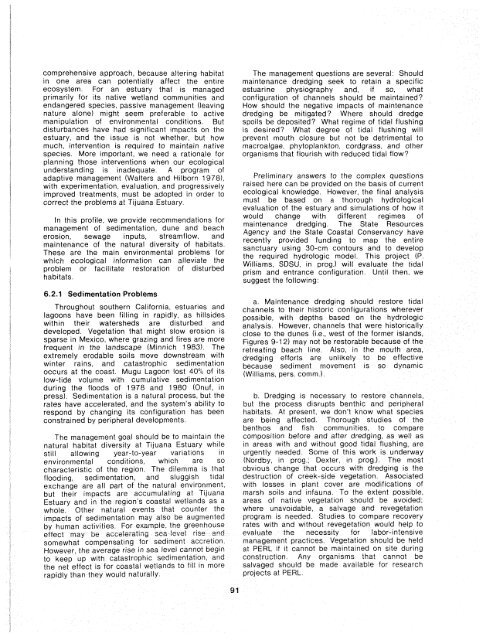The Ecology of Tijuana Estuary, California: An Estuarine Profile
The Ecology of Tijuana Estuary, California: An Estuarine Profile
The Ecology of Tijuana Estuary, California: An Estuarine Profile
Create successful ePaper yourself
Turn your PDF publications into a flip-book with our unique Google optimized e-Paper software.
comprehensive approach, because altering habitat<br />
in one area can potentially affect the entire<br />
ecosystem. For an estuary that is managed<br />
primarily for its native wetland communities and<br />
endangered species, passive management (leaving<br />
nature alone) might seem preferable to active<br />
manipulation <strong>of</strong> environmental conditions. But<br />
disturbances have had significant impacts on the<br />
estuary, and the issue is not whether, but how<br />
much, intervention is required to maintain native<br />
species. More important, we need a rationale for<br />
planning those interventions when our ecological<br />
understanding is inadequate. A program <strong>of</strong><br />
adaptive management (Walters and Hilborn 19781,<br />
with experimentation, evaluation, and progressively<br />
improved treatments, must be adopted in order to<br />
correct the problems at <strong>Tijuana</strong> <strong>Estuary</strong>.<br />
<strong>The</strong> management questions are several Should<br />
ma~ntenance dredg~ng seek to retam a specific<br />
estuarine physiography and, if so, what<br />
configuratlon <strong>of</strong> channels should be maintained?<br />
How should the negatrve Impacts <strong>of</strong> malntenance<br />
dredging be mit~gated? Where should dredge<br />
spo~ls be depos~ted? What regime <strong>of</strong> t~dal flushing<br />
IS des~red? What degree <strong>of</strong> t~dal flushlng w~ll<br />
prevent mouth closure but not be detr~mental to<br />
macroalgae, phytoplankton, cordgrass, and other<br />
organisms that flour~sh w~th reduced t~dal flow?<br />
Preliminary answers to the complex questions<br />
raised here can be provided on the basis <strong>of</strong> current<br />
ecological knowledge. However, the final analysis<br />
must be based on a thorough hydrological<br />
evaluation <strong>of</strong> the estuary and simulations <strong>of</strong> how it<br />
would change with different regimes <strong>of</strong><br />
In this pr<strong>of</strong>ile, we provide recommendations for maintenance dredging, <strong>The</strong> State Resources<br />
management Of sedimentation, dune and beach Agency and the State Coastal Conservancy have<br />
sewage streamflow, and recently provided funding to map the entire<br />
maintenance <strong>of</strong> the natural diversity <strong>of</strong> habitats.<br />
sanctuary using 30-cm contours and to develop<br />
<strong>The</strong>se are the main environmental problems for<br />
the required hydrologic model. This project (P.<br />
which ecological information can alleviate the<br />
Williams SDSU, in prog,) will evaluate the tidal<br />
problem or facilitate restoration <strong>of</strong> disturbed prism entrance configuration, Until then, we<br />
habitats.<br />
suggest the following:<br />
6.2.1 Sedimentation Problems<br />
a Maintenance dredging should restore t~dal<br />
Throughout 'Outhern estuar'es and channels to thelr histor~c configurations wherever<br />
lagoons have been filling in rapldly, as hlllsldes<br />
depths based on the hydrologic<br />
watersheds are and analysis However, channels that were h~storically<br />
deveioped. that might 'low Is<br />
close to the dunes (I e., west <strong>of</strong> the former ~slands,<br />
sparse In Mexico, where grazing and fires are more Figures 9-12) may not be restorable because <strong>of</strong> the<br />
frequent In the landscape (Minnlch <strong>The</strong><br />
extremely erodable soils move downstream with<br />
retreating beach lrne<br />
dredging efforts are<br />
Also, in the mouth area,<br />
unlikely to be effective<br />
winter rains, and catastrophic sed~mentatlon because sediment movement is so dynamic<br />
occurs at the coast Mugu Lagoon lost 4O010 <strong>of</strong> ~ts<br />
low-tlde volume w~th cumulat~ve sedimentation<br />
(Wlll,ams, pers comm)<br />
during the floods <strong>of</strong> 1978 and 1980 (Onuf, In<br />
press). Sedimentat~on IS a natural process, but the b. Dredging is necessary to restore channels,<br />
rates have accelerated, and the system's abil~ty to but the process d~srupts benthic and perlpheral<br />
respond by changlng its configuratlon has been habltats At present, we don't know what species<br />
constrained by peripheral developments are being affected. Thorough stud~es <strong>of</strong> the<br />
benthos and fish commun~ties, to compare<br />
<strong>The</strong> management goal should be to maintain the composition before and after dredging, as well as<br />
natural habttat diversity at Tljuana <strong>Estuary</strong> wh~le In areas wrth and without good t~dal flushing, are<br />
still allowrng year-to-year var~at~ons In urgently needed Some <strong>of</strong> thrs work IS underway<br />
env~ronmental cond~tions, wh~ch are so (Nordby, in prog., Dexter, In prog.) <strong>The</strong> most<br />
character~st~c <strong>of</strong> the reglon <strong>The</strong> d~lemma IS that obvious change that occurs with dredg~ng IS the<br />
flood~ng, sed~mentat~on, and sluggish tidal<br />
exchange are all part <strong>of</strong> the natural envrronment,<br />
destruct~on <strong>of</strong> creek-side vegetal~on Assoc~ated<br />
w~th losses In plant cover are mod~ftcations <strong>of</strong><br />
but their Impacts are accumulatrng at Tljuana marsh soils and rnfauna TO the extent possible,<br />
<strong>Estuary</strong> and in the region's coastal wetlands as a areas <strong>of</strong> native vegetat~on should be avolded,<br />
whole Other natural events that counter the where unavo~dable, a salvage and revegetatron<br />
Impacts <strong>of</strong> sedlmentatton may also be augmented program IS needed. Stud~es to compare recovery<br />
by human activities For example, the greenhouse rates with and without revegetatlon would help to<br />
effect may be accelerating sea level rise a ~ d evaluate the necessity for labor-~ntens~ve<br />
somewhat compensatrng for sediment accret~on management practices. Vegetation should be held<br />
However, the average rtse tn sea level cannot begin at PERL if ~t cannot be maintained on site dur~ng<br />
to keep up w~th catastroph~c sedimentat~on, and<br />
the net effect is for coastal wetlands to fill In more<br />
constauct~on <strong>An</strong>y organisms that cannot be<br />
salvaged should be made available for research<br />
rapldly than they would naturally<br />
projects at PERL<br />
91

















